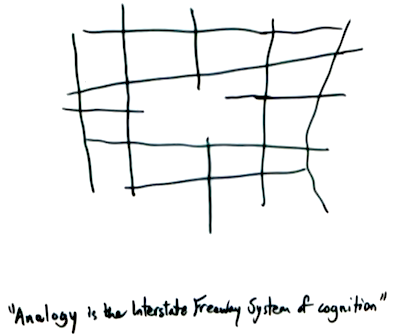
“Virtually every thought in this book (or in any book) is an analogy,” writes cognitive scientist Douglas Hofstadter in 2007’s I am a Strange Loop.
Indeed, analogous arguments are everywhere. They appear in the phrase “standing on the shoulders of giants,” and in Stuart Kauffman’s theory of adjacent possibilities, and in Janine Benyus’ advocacy for biomimicry: taking nature as a model, measure, and mentor. Each of these concepts implies that new thinking and practice emerge in reference to what has come before.
“We are constantly seeing, in new situations, the deep essence that we are familiar with from previous experience,” Hofstadter says in an On Point interview (“The Brain As An Analogy Machine”).
From his new book with Emmanuel Sander, Surfaces and Essences: Analogy as the Fuel and Fire of Thinking:
In this book about thinking, analogies and concepts will play the starring role, for without concepts there can be no thought, and without analogies there can be no concepts. This is the thesis that we will develop and support throughout the book.
The index to Strange Loop lists analogies under two headers, those that are “serious examples” and those that are “throwaways” or “random examples.” When Hofstadter is at his hilarious best, the throwaways come so fast that one can miss the serious examples. But they are there as well.
The image above — hand-drawn, on a transparency — comes from Hofstadter’s 2006 Presidential Lecture at Stanford, which is delivered with gusto (and begins at 13:40 in the video below, “Analogy as the Core of Cognition”).

